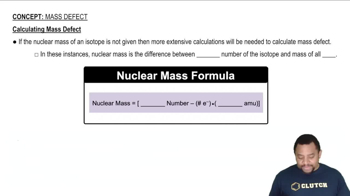Textbook Question
Why does a given nucleus have less mass than the sum of its constituent protons and neutrons?
374
views
 Verified step by step guidance
Verified step by step guidance



Calculate the binding energy (in MeV/nucleon) for the following nuclei. (a)58Ni (atomic mass = 57.93535)
Calculate the binding energy (in MeV/nucleon) for the following nuclei. (b) 84Kr (atomic mass = 83.91151)